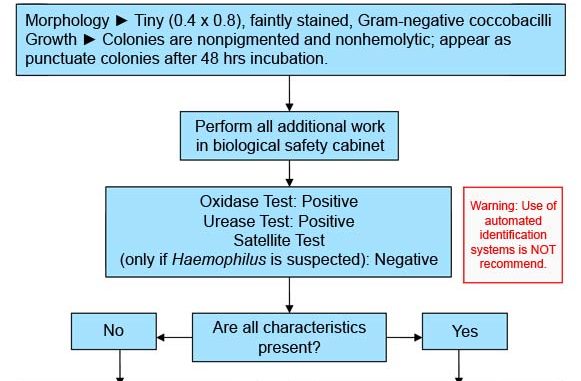
Brucella spp
Brucella is a fastidious, aerobic, small, gram-negative coccobacillus that is slow growing and difficult to isolate. Four species of Brucella are recognized causing infection in humans: Brucella abortus (cattle), Brucella melitensis (goats, sheep, and camels), Brucella suis (pigs), and Brucella canis (dogs). Primarily interest in clinical specimen is identification of genus rather than species. Those individuals who work with animals and those who have not been vaccinated against brucellosis are in risk of infection. Therefore, the patients are mostly- farmers, veterinarians, and slaughterhouse workers. They become infected either by direct contact or by aerosol from infected animal tissues. Brucellosis is also seen in individuals who ingest unpasteurized dairy products contaminated with brucellae. Brucella spp is one the microorganism which is at potential risk for being used in a bioterrorism.
Sample collection:
- Blood or bone marrow: Collect aseptically during fever episode.
- Place specimen immediately in blood culture bottles.
- Other specimens: CSF, lymph nodes, joint fluid, and liver or spleen biopsy specimens
Requirements:
- Incubator with 5 to 10% CO2
- 10% Ferric chloride
- Antiserum to Brucella from febrile agglutination test
- Microscope slides
Culture media for Brucella:
- Primary culture Media
- Biphasic blood culture media
- Septi-Chek (Chocolate, MacConkey, and malt agar with Brain Heart Infusion (BHI)
- Columbia broth
- PML biphasic media (Chocolate and BHI agar with Trypticase soya broth (TSB))
- Castaneda bottles (TSB or brucella broth and agar)
- Media for blind subculture or for positive cultures
- Blood agar preferably with BHI base
- Chocolate agar
- Brucella agar
Laboratory processing of blood sample and culture:
- Gloves should be worn to protect from skin exposure to the culture.
- When working with suspected Brucella isolates, all manipulations of the culture, including oxidase and catalase tests and Gram staining, should be performed in a biological safety cabinet to minimize the possibility of exposure to aerosols of this organism.
- For primary biphasic culture media, Incubate the culture plate for 21 days; invert twice daily for the first 2 days and then daily for the remaining days of incubation.
- Subculture an aliquot at day 10 to Blood agar, Chocolate agar, or brucella agar and incubate plates in 5 to 10% CO2 for at least 72 h.
- Colonies typically showing “dust-like” growth after overnight incubation on Blood agar and Chocolate agar. Colonies are tiny but smooth, glistening, raised with an entire edge, and white to cream color at 48 to 72 h.
- Brucella grows on both Blood and Chocolate agar without satelliting around staphylococcus. If the colony is growing only on Chocolate agar, subculture to Chocloate agar, MacConkey agar, and Blood agar with a spot of Staphylococcus aureus ATCC 25923 added after inoculation of Blood agar with the suspected colony. If equivalent growth is seen on Chocolate agar and Blood agar but not on MacConkey or Eosin methylene blue agar, and the organism does not satellite around the Staphylococcus, it is likely to be Brucella.
- The most common organisms misidentified as Brucella spp. are Haemophilus spp., which will satellite around the staphylococcus on the Blood agar
- Brucellae grow on the entire Blood agar without inhibition.
Biochemical tests:
- Gram staining = Gram negative coccobacilli
- Catalase test = Positive
- Oxidase test = Positive
- Rapid urea test = Positive
- Phenylalanine deaminase test (PDA): If the urea test is positive and the disk or tablet contains phenylalanine,
- Add 2 drops of 1 N HCl to acidify the alkaline urea reaction and Perform Phenylalanine deaminase test by adding ferric chloride to tube. Brucellae are negative for PDA
Serological tests:
- Prepare a suspension of the isolate in 1.0% formalinized saline to match a no. 2.0 McFarland standard.
- Let sit overnight to kill the organisms.
- Set up tube agglutination test using the positive control antiserum from the febrile agglutinin test and normal rabbit serum as a negative control.
- As a positive control, test the positive control antiserum with the antigen in the febrile agglutinin test
Organism confused with Brucella:
- Haemophilus aphrophilus, Eikenella, Actinobacillus actinomycetemcomitans, Capnocytophaga, and Kingella kingae; all are urea negative. However, some brucellae are urea negative.
- If the isolate is from a urine culture, it could be Oligella ureolytica,
- Psychrobacter phenylpyruvicus has the same phenotypic characteristics but is rare and is PDA positive.
- Some Bordetella spp. are urea positive but grow on MAC and are motile
